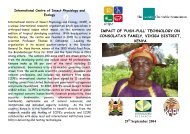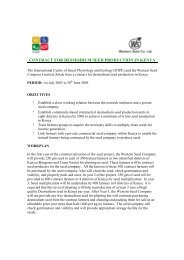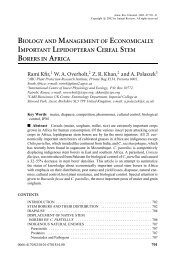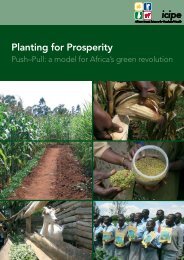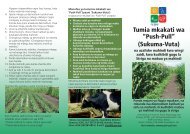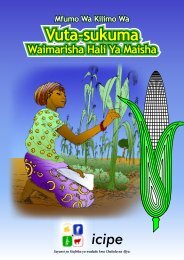A Primer on Planting and Managing 'PushâPull' Fields for Stemborer ...
A Primer on Planting and Managing 'PushâPull' Fields for Stemborer ...
A Primer on Planting and Managing 'PushâPull' Fields for Stemborer ...
- No tags were found...
Create successful ePaper yourself
Turn your PDF publications into a flip-book with our unique Google optimized e-Paper software.
• Apply <strong>on</strong>e teaspo<strong>on</strong>ful of triple superphosphate (TSP)fertiliser or two h<strong>and</strong>fuls of well decomposed farmyardmanure in each hole be<strong>for</strong>e planting Napier grass (Figure14).• Place a three-node cane into the ground, ensuring that twoof the nodes are covered, or place the root splits into theplanting holes <strong>and</strong> cover with soil (Figure 14).• In the first year, plant Napier grass be<strong>for</strong>e the rains so that ithas a start <strong>on</strong> the maize. The stemborer moths will like thelarger Napier grass <strong>for</strong> laying their eggs even more than themaize.<strong>Planting</strong> maize• Plant your maize in the field already surrounded by Napiergrass.• Ensure that the 1st row of maize is 1 m away from the innerrow of Napier grass.• The recommended spacing <strong>for</strong> maize is 75 cm betweenrows <strong>and</strong> 30 cm between hills in a row.• Apply <strong>on</strong>e teaspo<strong>on</strong>ful of triple superphosphate or twoteaspo<strong>on</strong>fuls of single superphosphate per hole.• Plant two maize seeds per hole <strong>and</strong> then thin to <strong>on</strong>e plantper hill after the first weeding.• Note: Napier rows should be planted so that they alternatewith maize rows (Napier should not be planted in the samerow with maize), so that ploughing of the field in the nextseas<strong>on</strong> will be easy (Figure 15).17




